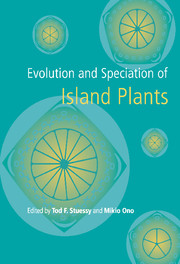Book contents
- Frontmatter
- Contents
- List of contributors
- Preface
- Acknowledgements
- Part one Hawaiian Islands
- Part two Juan Fernandez Islands
- Part three Southern and western Pacific Islands
- Part four General evolutionary patterns and processes on oceanic islands
- Introduction
- 11 Secondary compounds and evolutionary relationships of island plants
- 12 Chromosomal stasis during speciation in angiosperms of oceanic islands
- 13 The current status of our knowledge and suggested research protocols in island archipelagos
- Author index
- Taxon index
- Subject index
11 - Secondary compounds and evolutionary relationships of island plants
Published online by Cambridge University Press: 04 May 2010
- Frontmatter
- Contents
- List of contributors
- Preface
- Acknowledgements
- Part one Hawaiian Islands
- Part two Juan Fernandez Islands
- Part three Southern and western Pacific Islands
- Part four General evolutionary patterns and processes on oceanic islands
- Introduction
- 11 Secondary compounds and evolutionary relationships of island plants
- 12 Chromosomal stasis during speciation in angiosperms of oceanic islands
- 13 The current status of our knowledge and suggested research protocols in island archipelagos
- Author index
- Taxon index
- Subject index
Summary
Abstract
Studies of plants, endemic or otherwise, on islands have disclosed the presence of a wide variety of natural products, acetylenes, alkaloids, cyanogenic glycosides, flavonoids, terpenoids and others. In the vast majority of instances, the chemistry of the island species parallels the chemistry of related continental species with regard to the class or classes of natural product under consideration. In some cases, compound profiles are very similar to those of continental species; in some, simpler profiles are seen, while in others, enriched arrays of compounds occur. In a only a few well-documented cases, notably cyanogenic species on the Galapagos Islands, has loss of the compounds in question apparently occurred.
Many classes of naturally occurring compounds have been implicated as herbivore feeding deterrents and that they exert that activity because of their toxicity. I offer the alternative suggestion that their effectiveness arises from simply tasting bad. It has been suggested that deterrent compounds would be lost if the predator were removed. However, in the absence of herbivore pressure most island species appear to maintain their capacity to manufacture these putative defensive compounds. Therefore, I suggest that the compounds may serve other functions in the plant.
The aims of this chapter are to review the literature concerning secondary compounds reported from island species with emphasis on endemics and to comment on: (1) the use of these data to evaluate evolutionary relationships with mainland species and with each other; and (2) the operation of these compounds in defensive roles in the island environment.
- Type
- Chapter
- Information
- Evolution and Speciation of Island Plants , pp. 233 - 306Publisher: Cambridge University PressPrint publication year: 1998
- 2
- Cited by



